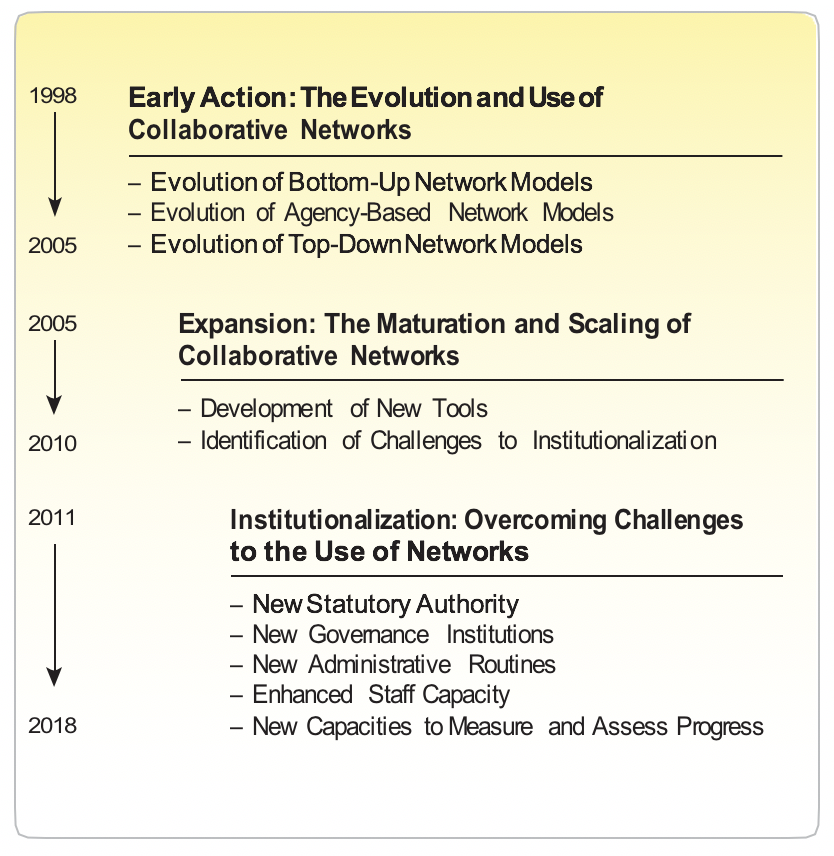
Government Reform over the Past 20 Years - Part 5, Becoming Collaborative

In the IBM Center’s new book, Government For The Future: Reflection and Vision for Tomorrow’ Leaders, we have identified six major trends that have driven government management reforms. This is the fourth in a six-part series where we highlight each trend; part two summarizes the evolution of performance management in U.S. federal, state, and local governments. For more detail, see the chapter on Becoming Collaborative.
The concept of “collaborative governance”—that is, working jointly across the traditional boundaries of governmental agencies, and between the public and private sectors—has proven an effective strategy for implementing policy initiatives over the past two decades in an increasingly interdependent environment. The descriptive terms for these phenomena vary—from networks and collaborations to partnerships, horizontal government, boundary spanning, joined up government, and more.
What Drives Collaborative Governance?
Professor Rosemary O’Leary has described how government has steadily increased its use of collaborative approaches in lieu of the traditional hierarchical and bureaucratic approach. She says there are several explanations for this shift.
- First, most public challenges are larger than one organization, requiring new approaches to addressing public issues such as housing, pollution, transportation, andhealthcare.
- Second, collaboration helps to improve the effectiveness and performance of programs by encouraging new to provide services.
- Third, technology advances helped “organizations and their employees to share information in a that is integrative andinteroperable.”
- Finally, citizens are seeking additional avenues for engaging in governance, resulting in new and different forms of collaborative problem solving and decision making.
Evolution of Collaborative Networks
Progress in this area has moved through three major phases over past 20 years, as shown in the following chart:
Early action: Informal networks of people, programs, and organizations—and the use of partnerships (a more formalized approach)—grew organically, largely from the bottom-up, as pragmatic responses to specific situations. These included community-led efforts to improve the water quality of rivers, as well as the Federal Emergency Management Agency’s efforts to prevent future damage to communities facing natural disasters—versus only responding to a community after a disaster has occurred.
Expansion: Policy makers began to proactively use network- based, collaborative governance models to address broader issues, such as improving food safety, addressing changes brought about by climate change, cross-agency law enforcement efforts, and creating veteran-centric approaches to myriad resources available to veterans.
Institutionalization: Statutory authority, strategic plans, and capacity-building efforts helped legitimize and provide the foundation for policymakers to use collaborative networks in a wide array of policy arenas. This has been reflected in statutory provisions creating cross-agency priority goals, Office of Management and Budget directives, and presidential directives to use collaborative approaches and to develop a cadre of career executives with experience working across organizational boundaries. Some Congress appropriated funding has also specifically targeted these efforts.
In addition, there is a shift underway to create and use “platforms” to organize and deliver internal services. Platforms are electronic business models that have become a foundation for virtually frictionless transactions and interactions between “many-to-many”—like eBay, Facebook, Airbnb and Uber. Digital platforms may presage the future of how collaborative governance evolves.
Looking Forward
All of government will not suddenly transition to collaborative networks. And this model is not appropriate for everything that government does. As in the private sector, there will continue to be “dual operating systems,” with traditional hierarchies and collaborative networks operating side by side.
But, as the prevalence of collaborative governance increases, the use of “collaborative platforms” will grow as part of the broader family of collaborative network models. The platform concept is not new and has been widely adopted in the private sector. Businesses such as Uber, Airbnb, and Facebook all have a platform-based business model. Currently, platform models in the public sector are more prevalent at the state and local levels, and in other countries, than in the U.S. federal government. They seem more sustainable than some other forms of networks.
What is meant by “platform”? Collaborative platforms are defined as organizations or programs with dedicated competencies and resources for facilitating the creation, adaptation, and success of multiple or ongoing collaborative projects or networks. They also noted that collaborative platforms specialize in facilitating, enabling, and to some degree regulating “many-to-many” collaborative relationships. More effective platforms do not mandate participation, but rather catalyze and facilitate voluntary efforts.
Two key platform characteristics are (1) to provide a framework for other activities to be organized, and (2) to provide a stable framework that is easily reconfigured to respond to changes in demand and the broader environment. The use of platforms may mitigate in ensuring the sustainability of networks by capturing information on progress, knowledge, and work products. The use of a platform may also allow networks to scale and more quickly pivot in response to external shocks, such as funding cuts or the loss of a critical stakeholder.
In a 2008 report, Integrating Service Delivery Across Levels of Government: Case Studies of Canada and Other Countries, Jeffrey Roy and John Langford describe how other countries have adopted digital platforms to improve the delivery of services to citizens. They wrote that public services are “traditionally delivered by a plethora of government agencies via programs that are not connected to each other.” They found a global movement to be more citizen-centric in the design and delivery of services using a network approach that relies on the use of digital platforms. This is being done in countries such as Canada, Belgium, Denmark, and Australia.
At the U.S. federal level, this approach is not yet widely used in citizen interactions. However, the federal government has committed to the use of “enterprise platforms” for internal services, which is more about integrating services onto a common platform than using a voluntary collaborative networking approach. Examples include the move to shared services for human resources and payroll, the creation of the Defense Health Agency that is a new platform for providing healthcare services such as pharmaceutical support across military services, and the Department of Homeland Security’s development of a multiagency operations center. As state and local citizen services platforms multiply and gain experience in delivering integrated services in the coming years, this model will likely be adopted more widely at the federal level as well.




